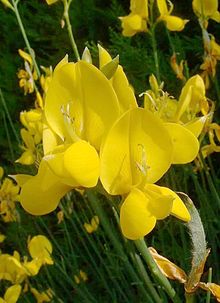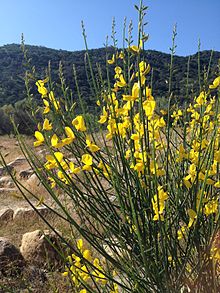Awl broom
| Awl broom | ||||||||||||
|---|---|---|---|---|---|---|---|---|---|---|---|---|

Prickly broom ( Spartium junceum ) |
||||||||||||
| Systematics | ||||||||||||
|
||||||||||||
| Scientific name of the genus | ||||||||||||
| Spartium | ||||||||||||
| L. | ||||||||||||
| Scientific name of the species | ||||||||||||
| Spartium junceum | ||||||||||||
| L. |
The Spanish broom ( Spartium junceum ), also bins broom or Spanish broom called, is the only kind of monotypic genus Spartium within the family of legumes (Fabaceae). It therefore does not belong to the genus of the gorse ( Genista ). It is one of the so-called cane bushes that shed their leaves in early summer. The photosynthesis happens only in the green branches to the evaporation of water to prevent through the leaves. The species is highly poisonous, poisoning leads to vomiting, respiratory paralysis and kidney damage.
description
The rush broom is a deciduous, 2 to 3 meter high, upright and richly branched, broadly bushy shrub with gray-barked trunks. The young twigs are rush-like , finely grooved, glabrous, rounded and very flexible. They later turn gray-brown and have green vertical stripes. The winter buds are very small. The simple and sessile leaves are alternate. They are green on both sides, oblong-lanceolate and 1.5 to 3 centimeters long and 3 millimeters wide. The upper side of the leaf is glabrous, the central rib of the underside of the leaf is hairy. They are dropped early. Stipules are missing.
The flowers are bright yellow and very fragrant. They are 2 to 2.5 centimeters tall and stand on 5 millimeter long flower stalks in long, loose clusters at the end of young shoots. The calyx is single-lipped and five-toothed and split open at the top. The flag is big and more or less bent back. The wings are shorter than the inwardly curved keel. The outside of the boat and wings are silvery hairy. The ten stamens are fused together for unequal lengths. The single carpel is on top. Flowering time is from April to June. The fruits are 5 to 10 centimeters long, laterally flattened, slightly curved, black-brown pods that narrow between the seeds . The pods are initially hairy and silky and later balding. They contain 10 to 20 shiny, red-brown seeds 4 millimeters long. The pods usually only open explosively a long time after the seeds have ripened. The fruit leaf halves are rolled up in a screw-like manner and the seeds are thrown far away.
The number of chromosomes is 2n = 46 or 52.
Distribution and location requirements
The awl broom can be found all over the Mediterranean, in Europe it is found on the Iberian Peninsula , in France , on the Apennine Peninsula and in the Balkans . However, it is missing on the Balearic Islands . In Asia the distribution area extends over Asia Minor , Syria , Palestine and the Caucasus . The species is also found in northwest Africa as far as Libya . It has grown wild in the Crimea , the Canary Islands and the Azores , but also in California , Mexico and the Andes of Peru and Bolivia , where it is called retama or ritama not only in Spanish but also in Quechua (not to be confused with the same generic name, which includes other species of the tribe Genisteae in the Mediterranean). In South Africa it is seen as a threat to the flora there.
The awl broom is a characteristic plant of the maquis and garigue . It can be found on dry slopes and rocks, on roadsides and fallow land, but also in sparse forests and cork oak stands. It prefers dry to fresh, nutrient-rich, weakly acidic to strongly alkaline, sandy, sandy gravelly or sandy loamy soils ; it is often found on limestone. However, it is missing in the Primeval Rock Makchie, where it is replaced by the thorny gorse ( Calicotome ). The awl broom is sensitive to moisture and frost and usually thrives in sunny, hot locations.
ecology
pollination
Pollination is carried out by large bees, similar to broom broom , in Central Europe mainly by wood bees ( Xylocopa ). If such an insect lands on the wings of the flower, they press on the boat, whereupon the boat begins to split under the pressure of the stylus and stamens. When about half of the boat is split open, the five shorter stamens pop out and hurl the pollen onto the insect's belly. If the rear end of the shuttle is split, the stylus shoots out and loads the pollen on the insect's back, whereupon the longer stamens also accommodate their pollen on the insect's back. The process cannot be repeated, pollination takes place only once. Honey bees cannot trigger the mechanism due to the lower weight; however, they collect residual pollen that may still be in the boat.
dryness
The broom is well adapted to dry locations. The already small leaves are shed in early summer. The photosynthesis takes place only after the green stems, whereby the loss of water reduced by evaporation.
Systematics and Etymology
The awl broom ( Spartium junceum ) is the only species in the thus monotypical genus Spartium . The genus is assigned to the tribe Genisteae in the subfamily of the butterflies (Faboideae).
The generic name Spartium is derived from the Greek word sparton for rope, which refers to the use of the rod-shaped branches. The epithet junceum is derived from the Latin juncus for rush .
The German names “Pfriemenginster” and “Pfriem” for the plant are based on Middle High German pfrimme (“Dornstrauch”, “Binsenginster”) and pfrieme (“ Pfriem ”, “pointed tool for piercing”).
Toxicity
All parts of the awl broom are highly poisonous. The main active ingredients are cytisine in all parts above ground and especially in the seeds, methylcytisine, anagyrine and sparteine in the flowers . Symptoms of poisoning are vomiting, kidney damage and respiratory paralysis.
use
The awl broom has been planted as an ornamental shrub in Central Europe since the 16th century because of its handsome flowers, and varieties with double flowers were also bred. In the viticulture climate it is completely hardy, but also proves to be surprisingly hard in other areas of Germany. In the past, the species was also used as a medicinal plant and an emetic and laxative was obtained from young leaves and seeds. The shoots were used to weave baskets and also for shoes. In ancient times, ropes and ropes were made from the bast fibers .
proof
literature
- Andreas Roloff, Andreas Bärtels: Flora of the woods. Purpose, properties and use . 3rd, corrected edition. Eugen Ulmer, Stuttgart (Hohenheim) 2008, ISBN 978-3-8001-5614-6 , pp. 617 .
- Bruno P. Kremer: Shrub trees . Recognize & determine. In: Steinbach's nature guide . Mosaik, Niedernhausen 2002, ISBN 3-576-11478-5 , p. 120 .
- Ingrid Schönfelder, Peter Schönfelder : The cosmos Mediterranean flora . 3. Edition. Franckh, Stuttgart 1999, ISBN 3-440-07803-5 , pp. 106 .
- Ulrich Hecker: Trees and Bushes . FSVO manual. BLV Buchverlag, Munich 2006, ISBN 3-8354-0021-5 , p. 384-385 .
Individual evidence
- ↑ a b c d Bruno P. Kremer: Shrub trees , p. 120
- ↑ a b Lutz Roth , Max Daunderer , Kurt Kormann : Toxic Plants - Plant Poisons. Poisonous plants from AZ. Emergency assistance. Occurrence. Effect. Therapy. Allergic and phototoxic reactions . 4th edition. Nikol, Hamburg 2000, ISBN 3-933203-31-7 , pp. 675 (reprinted 1994).
- ↑ a b c d e f Hecker: Trees and Bushes , p. 384
- ↑ a b c d e Roloff et al .: Flora der Gehölze , p. 617
- ^ Erich Oberdorfer : Plant-sociological excursion flora for Germany and neighboring areas . 8th edition. Verlag Eugen Ulmer, Stuttgart 2001, ISBN 3-8001-3131-5 . Page 582.
- ↑ Diccionario Quechua - Español - Quechua, Academía Mayor de la Lengua Quechua, Gobierno Regional Cusco, Cusco 2005, pp. 5190f .: retama . s. Bot. (Spartium junceum Linneo). NEOL. Arbusto de la familia de las leguminosas, de flores papilonáceas amarillas .
- ↑ Teofilo Laime Ajacopa, Diccionario Bilingüe Iskay simipi yuyayk'ancha, La Paz, 2007, p. 102: ritama . s. Retama.
- ↑ Hecker: Trees and Bushes , pp. 384–385
- ↑ a b Hecker: Trees and Bushes , p. 385
- ^ Spartium junceum. Germplasm Resources Information Network (GRIN), accessed August 28, 2010 .
- ↑ Helmut Genaust: Etymological dictionary of botanical plant names. 3rd, completely revised and expanded edition. Nikol, Hamburg 2005, ISBN 3-937872-16-7 , p. 316 (reprint from 1996).
- ↑ Helmut Genaust: Etymological dictionary of botanical plant names. 3rd, completely revised and expanded edition. Nikol, Hamburg 2005, ISBN 3-937872-16-7 , p. 598 (reprint from 1996).
- ^ Friedrich Kluge , Alfred Götze : Etymological dictionary of the German language . 20th ed., Ed. by Walther Mitzka , De Gruyter, Berlin / New York 1967; Reprint (“21st unchanged edition”) ibid 1975, ISBN 3-11-005709-3 , p. 546 f.
- ↑ See also Adam Lonitzer : Kreuterbuch. Artificial Conterfeytunge of the trees, shrubs, hedges, herbs, grain, Gewuertze […]. Edited by Peter Uffenbach, (Frankfurt am Main 1557, further edition there 1630; last edition Augsburg 1783) Matthäus Wagner (printer and publisher), Ulm an der Donau 1679; New printing (Leipzig 1934 and by) Konrad Kölbl, (Grünwald near) Munich 1962, p. 103 ( Pfrimmen, Spartium. Chamaespartion, Klein Erdpfrimmen ).
- ↑ Peter Schütt , Hans Joachim Schuck, Bernd Stimm (ed.): Lexicon of tree and shrub species. The standard work of forest botany. Morphology, pathology, ecology and systematics of important tree and shrub species . Nikol, Hamburg 2002, ISBN 3-933203-53-8 , pp. 491 (reprinted 1992).
- ↑ Schönfelder, Schönfelder: Die Kosmos-Mediterranflora , p. 106
Web links
- Spartium junceum L. In: Info Flora , the national data and information center for Swiss flora . Retrieved November 12, 2015.
- Thomas Meyer: Data sheet with identification key and photos at Flora-de: Flora von Deutschland (old name of the website: Flowers in Swabia )


